CBSE Previous Year Question Papers Class 12 Maths 2018
Time allowed: 3 hours
Maximum marks : 100
General Instructions:
- All questions are compulsory.
- The question paper consists of 29 questions divided into four sections A, B, C and D. Section A comprises of 4 questions of one mark each, Section B comprises of 8 questions of two marks each, Section C comprises of 11 questions of four marks each and Section D comprises of 6 questions of six marks each.
- All questions in Section A are to be answered in one word, one sentence or as per the exact requirement of the question.
- There is no overall choice. However, internal choice has been provided in 1 question of Section A, 3 questions of Section B, 3 questions of Section C and 3 questions of Section D. You have to attempt only one of the alternatives in all such questions.
- Use of calculators is not permitted. You may ask for logarithmic tables, if required.
**Answer is not given due to the change in present syllabus
Section – A
Question 1.
Find the value of tan
-1
\( \sqrt{{3}} \) – cot
-1
(\( \sqrt{{-3}} \)) [1]
Solution:
We have,
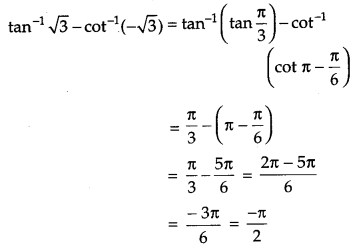
Question 2.
If the matrix A = \(\left[\begin{array}{rrr}{0} & {a} & {-3} \\ {2} & {0} & {-1} \\ {b} & {1} & {0}\end{array}\right]\) is skew-symmetric, find the values of’a’ and ‘b’. [1]
Solution:
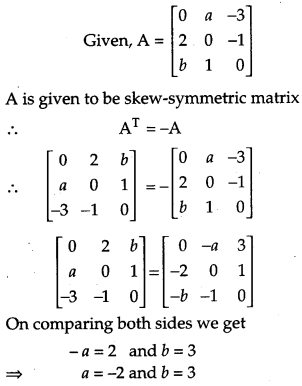
Question 3.
Find the magnitude of each of the two vectors \(\vec{a} \text { and } \vec{b}\), having the same magnitude such that the angle between them is 60° and their scalar product is \(\frac{9}{2}\) . [1]
Solution:
Let \(\vec{a} \text { and } \vec{b}\) be two such vectors.
![]()
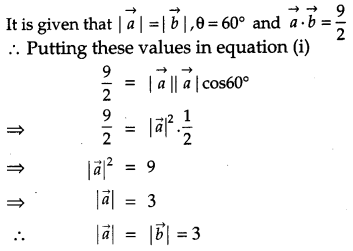
Question 4.
If a * b denotes the larger of ‘a’ and ‘b’ and if a o b = (a * b) + 3, then write the value of (5) o (10), where * and o are binary operations.** [1]
Section – B
Question 5.
Prove that: [2]

Solution:
R.H.S = sin
-1
(3x – 4x
3
)
Putting x = sin θ in R.H.S, we get
R.H.S = sin
-1
(3 sin θ – 4 sin
3
θ)
= sin
-1
(sin 3θ)
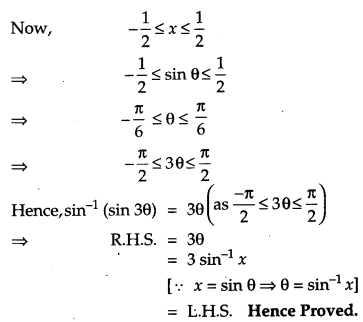
Question 6.
Given A = \(\left[\begin{array}{rr}{2} & {-3} \\ {-4} & {7}\end{array}\right]\), compute A
-1
and show that 2A
-1
= 9I – A. [2]
Solution:

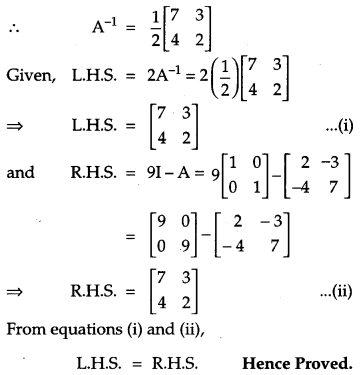
Question 7.
Differentiate \(\tan ^{-1}\left(\frac{1+\cos x}{\sin x}\right)\) with respect to x. [2]
Solution:
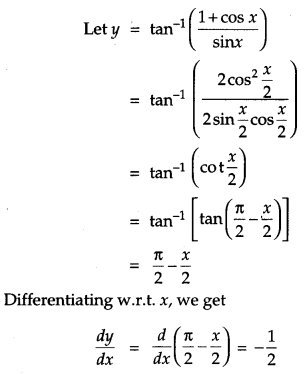
Question 8.
The total cost C(x) associated with the pro-duction of x units of an item is given by C(x) = 0.005x
3
– 0.02x
2
+ 30s + 5000. Find the marginal cost when 3 units are produced, where by marginal cost we mean the instantaneous rate of change of total cost at any level of output. [2]
Solution :
Cost function is given as
C(s) = 0.005x
3
– 0.02x
2
+ 30s + 5000
Marginal cost (MC) = \(\frac{d}{d x}(\mathrm{C}(x))\)
= 0.005(3x
2
) – 0.02 (2x) + 30
= 0.015x
2
– 0.04s+ 30
When x = 3,MC = 0.015(3)
2
– 0.04(3) + 30
= 0.135 – 0.12 + 30
= 30.015
Question 9.
Evaluate:

Solution:
We have,
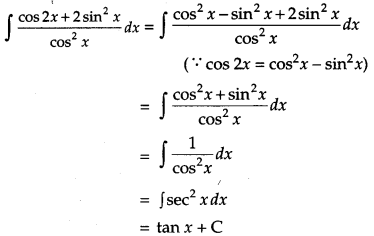
Question 10.
Find the differential equation representing the family of curves y = ae
bx + 5
, where a and b are arbitrary constants. [2]
Solution:
Given curve is
y = ae
bx + 5
…(i)
Differentiating (i) w.r.t. s, we get
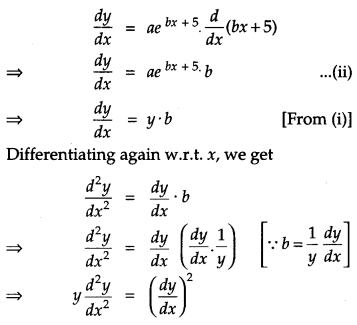
Question 11.
If θ is the angle between two vectors \(\hat{i}-2 \hat{j}+3 \hat{k}\) and \(3 \hat{i}-2 \hat{j}+\hat{k}\), find sin θ. [2]
Solution:
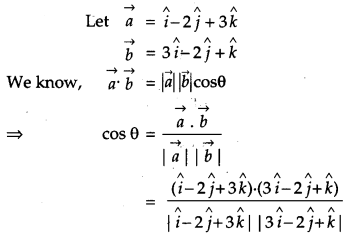
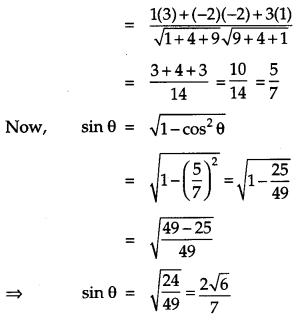
Question 12.
A black and a red die are rolled together. Find the conditional probability of obtaining the sum 8, given that the red die resulted in a number less than 4. [2]
Solution :
The sample space has 36 Outcomes. Let A be event that the sum of observations is 8.
∴ A = {(2, 6), (3, 5), (5, 3), (4, 4), (6, 2)}
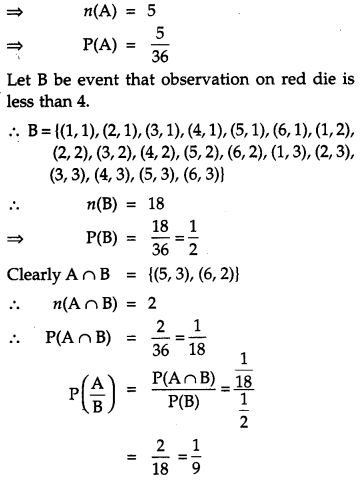
Section – C
Question 13.
Using properties of determinants, prove that: [4]

Solution:
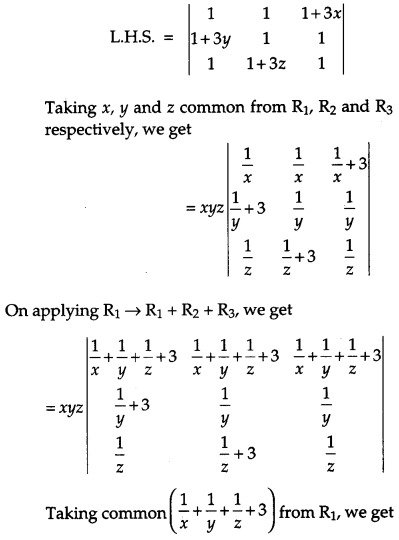
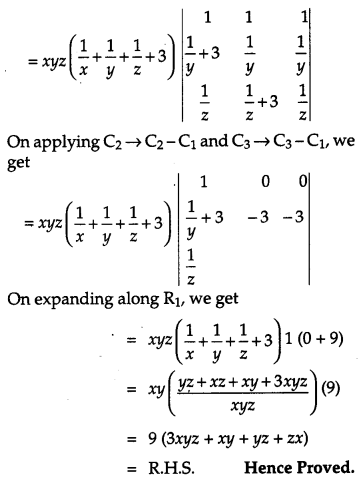
Question 14.
If (x
2
+ y
2
)
2
= xy, find \(\frac{d y}{d x}\). [4]
Solution:
We have,
(x
2
+ y
2
)
2
= xy …(i)
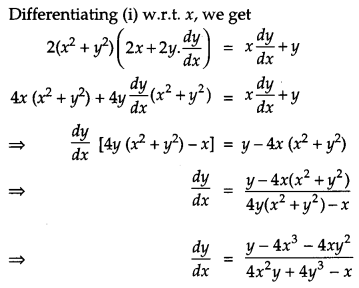
OR
If x = a(2θ – sin 2θ) and y = a(1 – cos 2θ), find \(\frac{d y}{d x}\) when θ = \(\frac{\pi}{3}\).
Solution:
Given, x = a (2θ – sin 2θ)
and y = a (1 – cos 2θ)
Differentiating x* and y w.r.t. θ, we get
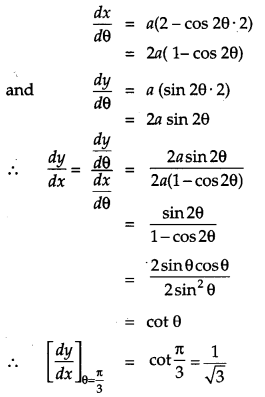
Question 15.
If y = sin(sin x), prove that: [4]

Solution:
Given, y = sin (sin x)
Differentiating y w.r.t. x, we get
\(\frac{d y}{d x}\) = cos (sin x) • cos x
Differentiating again w.r.t. x, we get
\(\frac{d^{2} y}{d x^{2}}\)= cos (sin x) (- sin x) + cos x [-sin (sin x)-cos x]
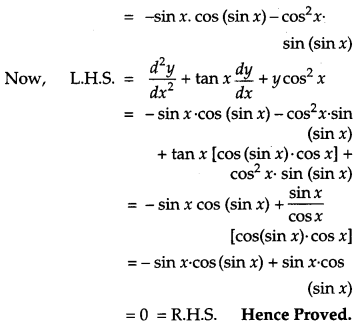
Question 16.
Find the equations of the tangent and the normal to the curve 16x
2
+ 9y
2
= 145 at the point (x
1
, y
1
), where x
1
= 2 and y
1
> 0. [4]
Solution:
Given curve is
16x
2
+ 9y
2
= 145 ….(i)
Since (x
1
, y
1
) lies on equation (i),
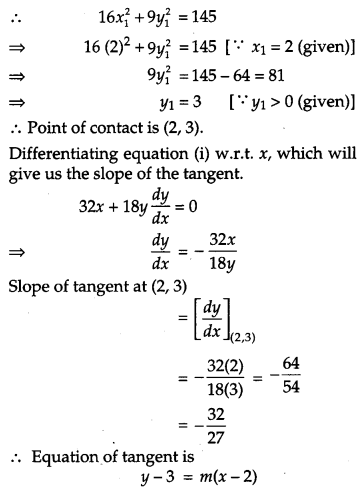
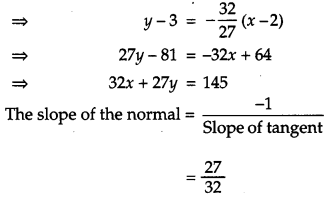
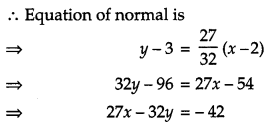
OR
Find the intervals in which the function
![]()
(a) strictly increasing,
(b) strictly decreasing.
Solution:
Given function is
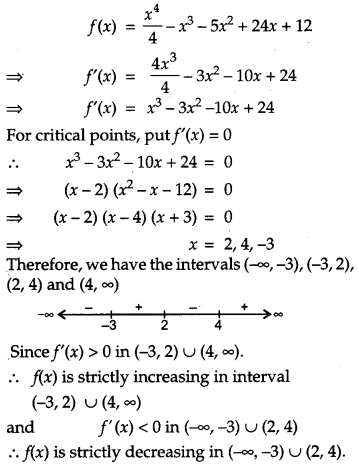
Question 17.
An open tank with a square base and vertical sides is to be constructed from a metal sheet so as to hold a given quantity of water. Show that the cost of material will be least when depth of the tank is half of its width. If the cost is to be borne by nearby settled lower income families, for whom water will be provided, what kind of value is hidden in this question ? [4]
Solution:
Let the length, breadth and height of the open tank be x, x and y units respectively.
Then, Volume (V) = x
2
y …(i)
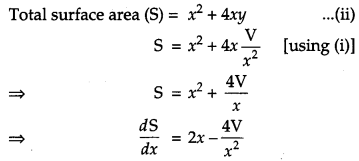
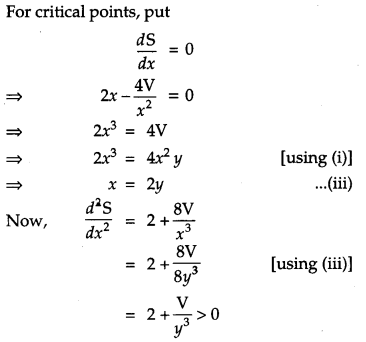
Area is minimum, thus cost is minimum when x = 2y.
i.e., depth of tank is half of the width.
Value : Any relevant value.
Question 18.
Find: [4]

Solution:
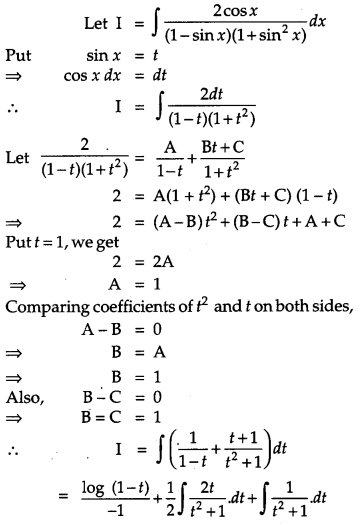

Question 19.
Find the particular solution of the differential equation e
x
tan ydx + (2 – ex) sec
2
ydy = 0, given that y = \(\frac{\pi}{4}\) when x = 0. [4]
Solution:
Given differential equation is,
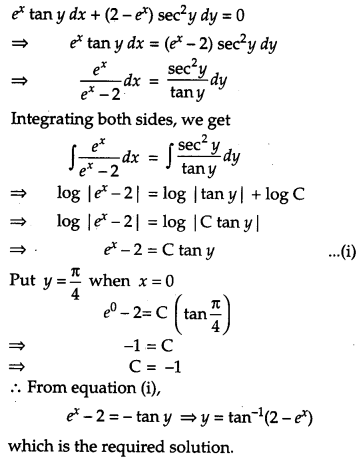
OR
Find the particular solution of the differential equation \(\frac{d y}{d x}\) + 2y tan x = sin x, given than y = 0 when x = \(\frac{\pi}{3}\).
Solution:
Given differential equation is,
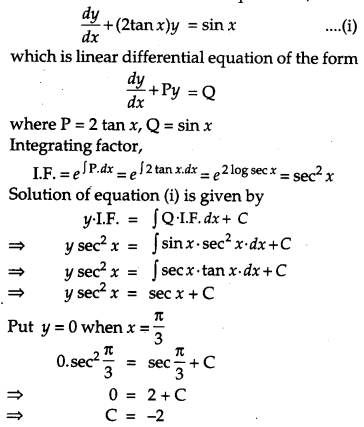
Hence, particular solution is
y sec
2
x = sec x – 2
or y = cos x – 2 cos
2
x
Question 20.
Let \(\vec{a}=4 \hat{i}+5 \hat{j}-\hat{k}, \vec{b}=\hat{i}-4 \hat{j}+5 \hat{k} \text { and } \vec{c}=3 \hat{i}+\hat{j}-\hat{k}\) Find a vector d which is perpendicular to both \(\vec{c} \& \vec{b} \text { and } \vec{d} \cdot \vec{a}=21\). [4]
Solution:
Given,
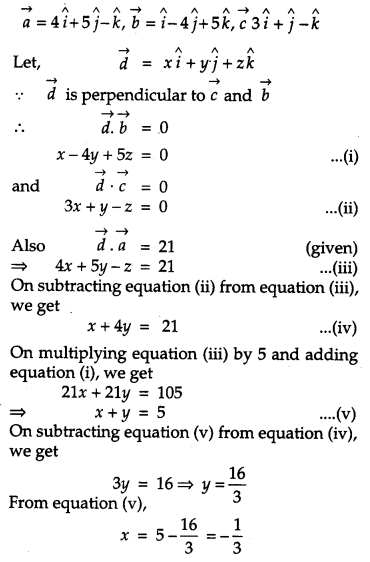
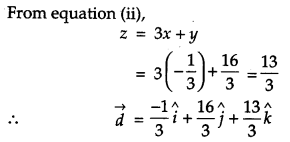
Question 21.
Find the shortest distance between the lines \(\vec{r}=(4 \hat{i}-\hat{j})+\lambda(\hat{i}+2 \hat{j}-3 \hat{k})\) and \(\vec{r}=(\hat{i}-\hat{j}+2 \hat{k})+\mu(2 \hat{i}+4 \hat{j}-5 \hat{k})\) [4]
Solution:
Given lines are
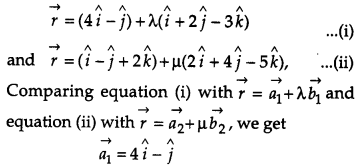
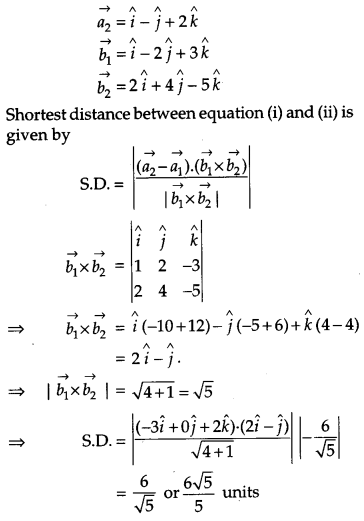
Question 22.
Suppose a girl throws a die. If she gets 1 or 2, she tosses a coin three times and notes the number of tails. If she gets 3, 4, 5 or 6, she tosses a coin once and notes whether a ‘head’ or ‘tail’, is obtained. If she obtained exactly one “tail7, what is the probability that she threw 3, 4, 5 or 6 with the dice? [4]
Solution :
Let E
1
be the event that girl gets 1 or 2 on the roll and E
2
be the event that girl gets 3, 4, 5, or 6 on the roll of a die.

Let A be the event that she gets exactly one tail. If she tossed coin 3 times and gets exactly one tail then possible outcomes are HTH, HHT, THH
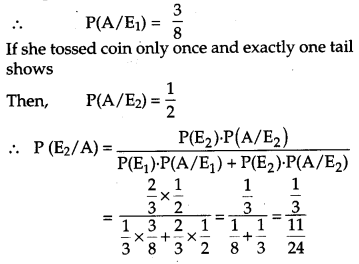
= \(\frac{8}{11}\)
Question 23.
Two numbers are selected at random (without replacement) from the first five positive integers. Let X denote the larger of the two numbers obtained. Find the mean and variance of X. [4]
Solution:
First five positive integers are 1, 2, 3, 4, 5. We select two positive numbers in 5 × 4 = 20 ways. Out of these, two numbers are selected at random. Let X denote larger of the two selected numbers. Then, X can have values 2, 3, 4 or 5.
P(X = 2) – P (larger no. is 2) = {(1, 2) and (2, 1)}
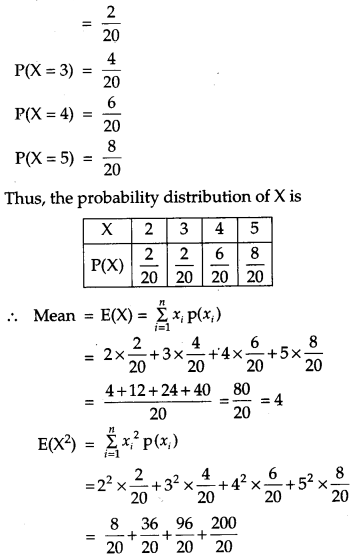

Therefore, mean and variance are 4 and 1 respectively.
Section – D
Question 24.
Let A = {x ϵ Z : 0 ≤ x ≤ 12}. Show that R = {(a, b): a, b ϵ A, | a – b | is divisible by 4} is an equivalence relation. Find the set of all elements related to 1. Also write the equivalence class [2]. [6]
Solution:
Given, R = {(a, b): a, b ϵ A, | a – b | is divisible by 4}
Reflexivity: For any a ϵ A
| a – a | = 0, which is divisible by 4
(a, a) ϵ R
So, R is reflexive.
Symmetry: Let (a, b) ϵ R
⇒ | a – b | is divisible by 4
⇒ | b – a | is divisible by 4 [ ∵ | a – b | = | b – a | ]
⇒ (b, a) ϵ R
So, R is symmetric.
Transitive : Let (a, b) ϵ R and (b, c) ϵ R
⇒ | a – b | is divisible by 4
⇒ | a – b | = 4k
∴ a – b = ± 4k, k ϵ Z …(i)
Also, |b – c| is divisible by 4
⇒ |b – c| = 4m
∴ b – c = ±4m, m ϵ Z …(ii)
Adding equations (i) and (ii)
a – b + b – c = ±4 (k + m)
⇒ a – c = ±4 (k + m)
|a – c | is divisible by 4,
⇒ (a, c) ϵ R
So, R is symmetric.
⇒ R is reflexive, symmetric and transitive.
∴ R is an equivalence relation.
Let x be an element of R such that (x, 1) ϵ R
Then | x – 1| is divisible by 4
x – 1 = 0, 4, 8, 12,
⇒ -x = 1, 5, 9 (∵ x ≤ 12)
∴ Set of all elements of A which are related to 1 are {1, 5, 9}.
Equivalence class of 2 i.e.
[2] = {(a, 2): a ϵ A, |a – 2| is divisible by 4}
⇒ | a – 2| = 4k(k is whole number, k ≤ 3)
⇒ a = 2, 6, 10
Therefore, equivalence class [2] is {2, 6, 10]
OR
Show that the function f : R → R defined by f(x) = \(\frac{x}{x^{2}+1}\), ∀x ϵ R is neither one-one nor onto. Also,if g: R → R is defined as g(x) = 2x – 1, find fog(x).
Solution:

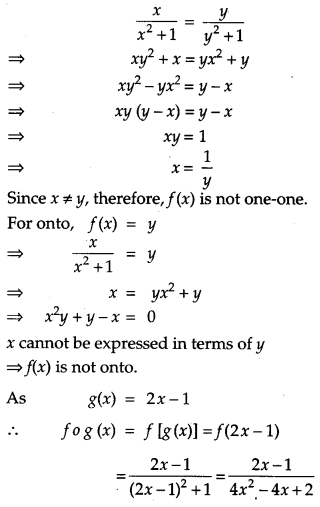
Question 25.
If A = \(\left[\begin{array}{rrr}{2} & {-3} & {5} \\ {3} & {2} & {-4} \\ {1} & {1} & {-2}\end{array}\right]\), find A
-1
. Use it to solve the system of equation: [6]
2x – 3y + 5z = 11
3x + 2y – 4z = -5
x + y – 2z = -3
Solution:
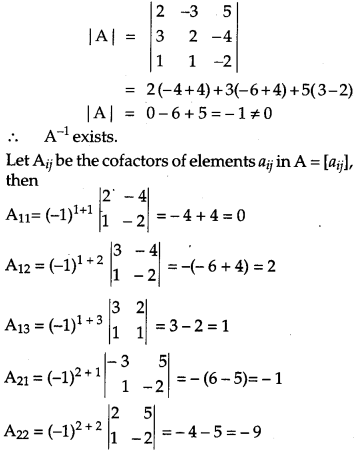
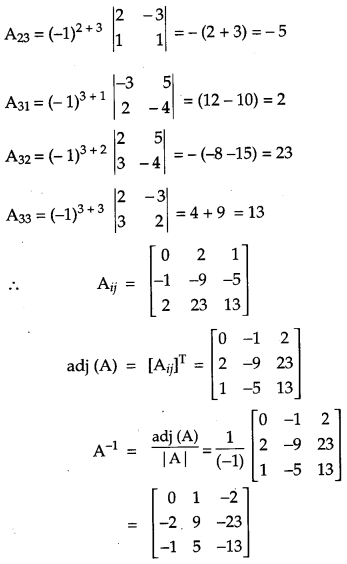
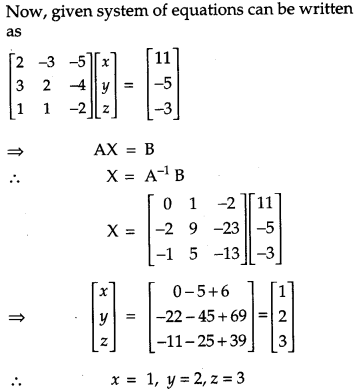
OR
Using elementary row transformations, find the inverse of the matrix:

Solution:
We know that, A = IA
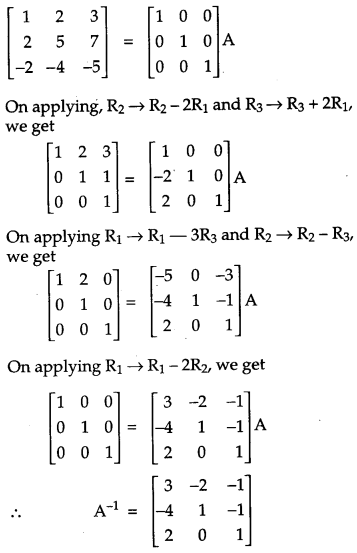
Question 26
Using integration, find the area of the region in the first quadrant enclosed by the X-axis, the line y = x and the circle x
2
+ y
2
= 32. [6]
Solution:
Given curve is
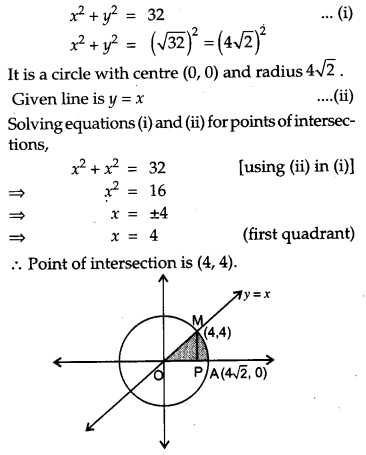
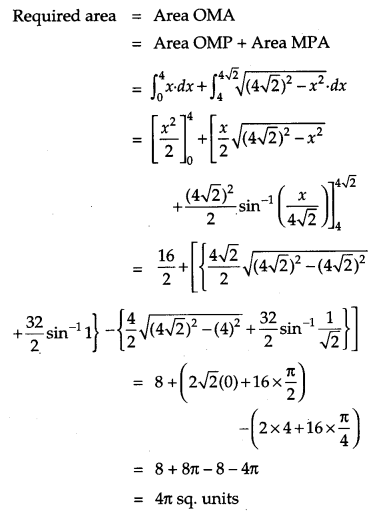
Question 27.
Evaluate: [6]

Solution:
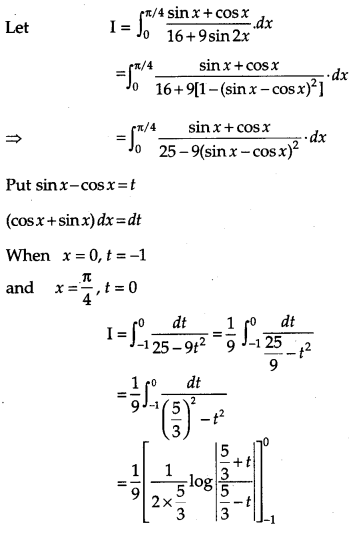
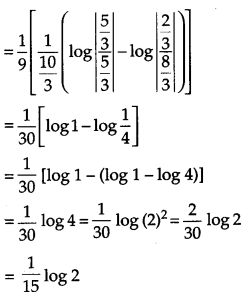
OR
Evaluate \(\int_{1}^{3}\left(x^{2}+3 x+e^{x}\right) d x\) as the limit of the sum.
Solution:
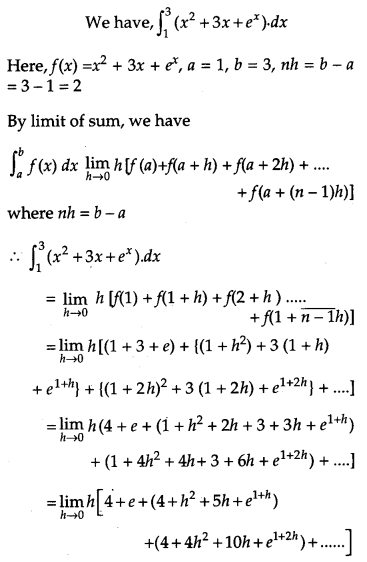
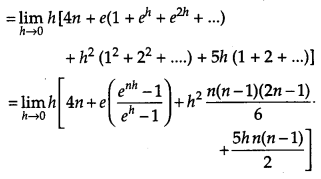
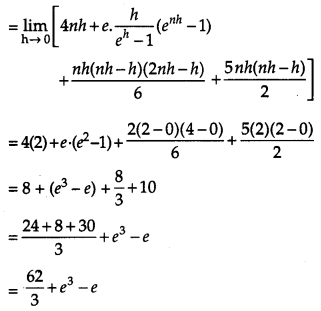
Question 28.
Find the distance of the point (-1, -5, -10) from the point of intersection of the line \(\vec{r}=2 \hat{i}-\hat{j}+2 \hat{k}+\lambda(3 \hat{i}+4 \hat{j}+2 \hat{k})\) and the plane \(\vec{r} \cdot(\hat{i}-\hat{j}+\hat{k})=5\). [6]
Solution:
Equation of line is
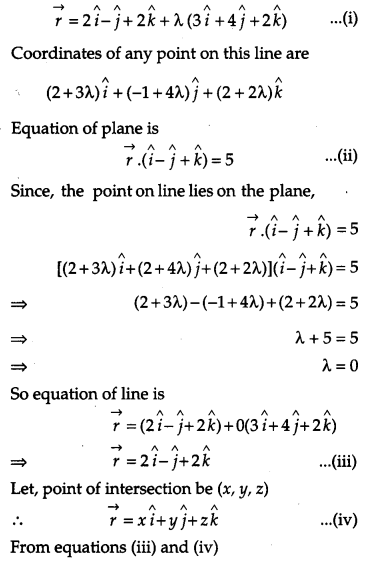
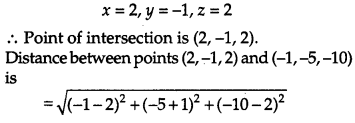

Question 29.
A factory manufactures two types of screws A and B, each type requiring the use of two machines, an automatic and a hand-operated. It takes 4 minutes on the automatic and 6 minutes on the hand-operated machines to manufacture a packet of screws ‘A’ while it takes 6 minutes on the automatic and 3 minutes on the hand- operated machine to manufacture a packet of screws ‘B’. Each machine is available for at most 4 hours on any day. The manufacturer can sell a packet of screws ‘A’ at a profit of 70 paise and screws ‘B’ at a profit of ₹1. Assuming that he can sell all the screws he manufactures, how many packets of each type should the factory owner produce in a day in order to maximize his profit ? Formulate the above LPP and solve it graphically and find the maximum profit [6]
Solution:
Let the number of packets of screw ‘A’ manufactured in a day be x and that of screw B be y.
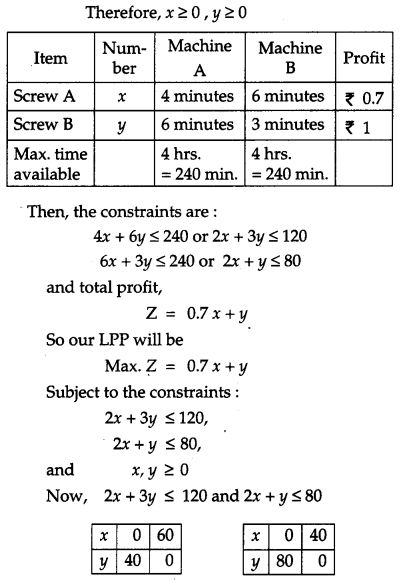
Plotting the points on the graph, we get the feasible region OABC as shown (Shaded).
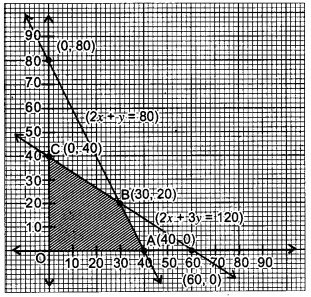
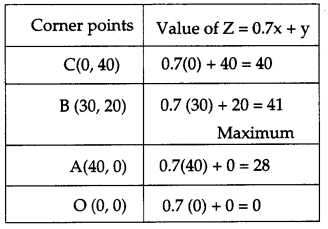
Hence, profit will be maximum if company produces 30 packets of screw A and 20 packets of screw B and maximum profit = ₹ 41.